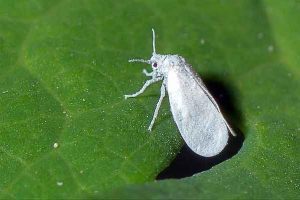
Yesterday, a neighbor saw small white insects on her flowers. Either large midges, or small mosquitoes.
And, of course, the first thing she asked me was what kind of new misfortune was it and what should I do now?
After the inspection, it turned out that whitefly settled on her houseplants. But how to deal with it - read in our article.
The content of the article:
- 1 Whitefly on Indoor Flowers
- 2 Methods of controlling whitefly on indoor plants
- 3 How to get rid of whiteflies
- 4 How to get rid of whiteflies using insecticides
- 5 How to deal with Whitefly?
- 6 External signs of a whitefly plant damage
- 7 Whitefly Control Measures
- 8 All about whiteflies and how to deal with them
- 9 How to identify larvae and adults
- 10 Where can pests be encountered?
- 11 Whitefly on indoor plants, how to fight?
- 12 Whitefly conditions
- 13 Whitefly Control
Whitefly on Indoor Flowers
The reason your favorite home plant may start to wither, dry, or vice versa rot often does not lie in poor care, but in damage to the flower by pests. But parasites can not always be noticed on time, in most cases it is possible to recognize their appearance only when characteristic symptoms of infection appear on a houseplant.
Rapid pest detection will help you quickly start appropriate treatment, including chemical treatment with insecticides. Poisoning the plant at random or as a prophylaxis is strictly not recommended, therefore, the accurate identification of the “enemy” is half the success.
A pest like whitefly infects many indoor flowers. The name speaks for itself - this parasite can be identified by the white color of its wings. The insect is very small, depending on the species, its length is 1-3 mm. The whitefly’s life cycle is rather complicated; you can find eggs, larvae, and adults on the leaves.
In total, there are more than two hundred species of whiteflies in nature; indoor plants and horticultural crops are most often affected by the greenhouse, tobacco (aka cotton) or citrus whiteflies. Flowers such as geranium, fuchsia, nightshade, eucalyptus, pomegranate, gloxinia, lantana belena, fern, calla, myrtle are especially affected by this pest.
Whitefly belongs to sucking parasites and is an extremely dangerous pest, which is quite difficult to remove. Its larvae deprive the plant of juices and carry phytopathogenic viruses, which, without taking proper measures, leads to the death of the flower.
The reasons for the appearance of whiteflies are often such factors:
- warmly;
- humidity;
- stale air;
- accuracy of plants.
It is very important in conditions of high temperature and humidity to ensure the influx of fresh air, its natural movement. Also, the cause of infection can be soil brought into the house by an already sick plant (vegetable, melon, garden crop), whiteflies can get onto your flowers and simply through a window or open window.
Methods of controlling whitefly on indoor plants
It is unlikely to cope with the whitefly at one time - get ready to work on its extermination in several stages. Do not pull with processing plants - whiteflies multiply very quickly. The female lays about 300 eggs every 25 days, which after 2 weeks turn into larvae sucking the plant's juice.
It is necessary to begin the fight against whitefly with the hygienic treatment of plants. Create conditions for flowers so that in the morning there is a slight coolness - this will prevent whiteflies from flying. Take the plant to the bathroom and carefully wash the leaves from pests, especially pay attention to the back of the foliage.
Replace soil; contaminated - dispose of. If you cannot create a temporary coolness, use a vacuum cleaner to catch flying pests and rinse the larvae with water. If your indoor plant can tolerate low temperatures - below 15 degrees, optimally 12-14, then just put it in the "cold" for 7-10 days.
However, they do not completely suppress whitefly at the stage of transformation of larvae into so-called nymphs; therefore, it is recommended to treat the plant 2-3 times every 7-8 days, as well as combine treatment with biologics based on an entomopathogenic fungus, for example, Verticillin.
After washing, the plant is treated according to the instructions (sprayed, spilled soil) and wrapped with polyethylene to create a "toxic greenhouse". The chemical will continue to evaporate and kill the larvae; if the treated plant is left without a bag, then the whitefly is likely to survive.
Such a popular recipe helps to get rid of whiteflies: garlic is peeled and chopped, poured with water (proportions 1 to 5), insisted for 5-6 days, the infected plant is filtered and sprayed with this infusion.
How to get rid of whiteflies
Tiny white butterflies can seem completely harmless: it does not even occur to some that these insects are somehow connected with the death of plants. Who is this whitefly? And how to get rid of it?
How to recognize a whitefly
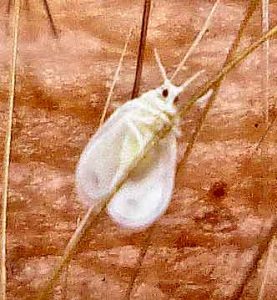
Whiteflies are active throughout the year and are distinguished by their ability to rapidly reproduce.
They lay eggs on the back of the leaves, hidden from sunlight.
The body of the hatched larva is flat and translucent.
Young individuals move little: they need enough juice from the leaf on which they live to feed. Most often, whiteflies damage flowers such as:
- geranium;
- fuchsia;
- begonia;
- orchid;
- balsam;
- begonia;
- heliotrope.
After itself, the insect leaves loose sugary secretions, on which a sooty mushroom will soon develop.A plant dying due to whiteflies can be recognized by the discoloration and deformation of its leaves. Soon they begin to fall, and at the same time with them are flower buds.
Whitefly is very tenacious and easily moves to more and more new plants. In the house, she can “move” even to another room, if only there are flowers. Sometimes an insect lives in greenhouses or in open ground.
Whitefly on flowers: how to get rid mechanically
The easiest method of controlling whiteflies is to remove insects from plants manually. To do this, tear off the affected leaves and burn them. After you need to rake the earth in a pot.
The remaining leaves should be wiped with soapy water or plain water, and then dried. You can also hang around the plants sticky tapes for catching flies: whiteflies also come across them, but, of course, only adults.
If the colony of flies is especially active on some not very favorite flower, then it makes sense to sacrifice it: you can be sure that the insects are completely destroyed.
Flies in flowers: how to get rid of folk remedies
Whitefly is not very susceptible to chemicals: insects simply fly away “until better times”, but very soon return. To begin with, you should try the struggle with folk methods:
- Pour boiling water over 100 g of chopped yarrow. Let it brew for 5 hours. Then strain and add a little dishwashing detergent. The resulting solution must be wiped off the affected leaves.
- You will need to pour 80 g of dried peels of lemon or orange with cold water. Wait 18-24 hours and add 2 tbsp. l soap solution. Treat insect-infected flowers for 5 days in a row. You can store the product in the refrigerator, but not more than 3 days.
- You should collect leaves from 6 dandelions and finely chop the rhizomes of the flowers. The resulting ingredients need to pour 1 liter of hot water and wait until the infusion has cooled. They need to spray indoor plants every 1.5 weeks. Also, dandelion infusion can be used to prevent the appearance of whiteflies in the house.
- It is necessary to finely chop or grate 3-4 garlic cloves and pour 0.5 g of water into the resulting slurry. After 4 days, the infusion will be ready for use. They should either wipe the leaves or spray the flower. This remedy is considered effective only at the initial stages of infection.
As a rule, in a house where there are not many plants, it is easy to get rid of whiteflies with folk remedies.
How to get rid of whiteflies using insecticides
There are many tools that fight insect pests. You can increase their effectiveness by adding a little shampoo or soap solution to the insecticide.
Thus, the chemical will linger on the plant and will have a longer effect on the whitefly. The most popular tools are:
- Actara. On average, it costs 8700 rubles. for 1 kg. The drug has established itself as an excellent insect repellent. It paralyzes the nutritional function of pests, as a result of which they die of hunger within 24 hours.
- Actellik. The average price is 3,100 rubles. for 1 liter Helps “thin out” whitefly colonies. Commonly used in combination with Actara.
- Kinmix. Estimated cost - 4200 per 1 liter. It affects the nervous system of the insect, disrupting the transmission of impulses through the body. The death of pests occurs within 1-1.5 days.
The use of insecticides should be approached with extreme caution. If they are used in a living room, then it must be aired after treatment. If a chemical is used in a greenhouse on fruit crops, it is possible to eat fruits no earlier than a few days later.
Whitefly in the greenhouse: how to get rid
You can deal with pests in the greenhouse by all of the above methods. If for some reason they are not suitable, consider the following options:
- Spiral from mosquitoes. It is necessary to light 4-5 spirals at night in the greenhouse. In the morning, you can find many corpses of insects. Since the larvae do not die from this, it is necessary to repeat the procedure 3-4 times;
- Ash. Sprinkle the soil under the plants with ash mixed with tobacco dust. Insects quickly retreat;
- Homemade traps. You will need to roll a cylinder of thick yellow paper. Inside, the surface should be sticky: a long hardening adhesive is suitable. Traps need to be updated until insects disappear from the greenhouse;
- Parasitic and predatory entomophages. They are great for fighting when there are a lot of plants. Commonly used are enkarsia and trichaporus. The number of predators depends on the area of the greenhouse: 15 pcs per 1 m2 of cucumbers, and 7-10 pcs per 1 m2 of tomatoes or eggplants.
It is very difficult to completely get rid of whiteflies, as more and more insects will hatch from the larvae. But sooner or later the moment will come when the pests will die before they have time to lay their eggs. This will be a victorious turning point in the fight against whitefly.
How to deal with Whitefly?
Whitefly is a dangerous plant pest. These small flying insects are a bit like miniature white moths swarm soaring above a disturbed plant. On the leaves you will find both pest eggs and their larvae in the form of small grayish grains. Let's figure out how to deal with it.
Description of whiteflies
European species of the family are usually about 1.3-1.8 mm in length (up to 3 mm). A little reminiscent of a small prayer-like Lepidoptera. They have 4 wings, which are covered with a white dusty coating, reminiscent of flour.
Whitefly diet
The whitefly's favorite diet primarily includes: fuchsia, begonia, balsam, passiflora, pelargonium, lanthanum. For lack of a favorite, whitefly can attack most houseplants. In greenhouse-greenhouse conditions, prefers tomatoes and cucumbers, but does not disdain other plants.
Prevention
Whitefly appears where high temperature is combined with high humidity (greenhouses, greenhouses - first of all), there is not enough ventilation, plants are placed too closely. For this reason, first of all, it is necessary to provide the plant with optimal moisture and temperature conditions and ventilation.
Natural enemies of whiteflies, for example, lacewings and ladybugs, can quickly destroy pests.
External signs of a whitefly plant damage
Usually whiteflies hide on the underside of leaves. On the upper side of the underlying leaves, a shiny coating appears (honeydew, or pad) - the stool of insects, on which soot fungi (“blacks”) subsequently develop, due to which the surface of the sheet becomes first white and then black.
It is believed that sooty mushrooms can greatly harm the plant, and not directly whiteflies. Sometimes, because of them, the growth of shoots stops.
Whitefly Control Measures
Biological methods of struggle
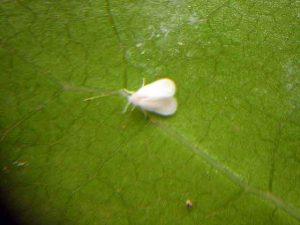
One of them is the placement in the greenhouse of pupae of the enkarsia parasite.
The female of this small insect lays its eggs in the body of the whitefly larva.
Moreover, the effectiveness of this method is very high. Also, to combat whiteflies, predatory bug Macrolofus is used.
Chemicals
In the fight against whiteflies, common insecticides are effective. It should be noted that it is dangerous for a long time to be in the room where the plants were treated with insecticides. Also, when processing it is necessary to use protective equipment: a respirator, glasses, gloves, work clothing.
- Actellik. Dilute the ampoule in 1 liter of water and treat during the pest. The consumption of the solution is up to 2 liters per 10 sq.m. No more than 4 treatments. The waiting period is 3 days.
- Verticillin W - 25 ml per 1 liter of water. Double spraying with an interval of 7-10 days.
- Confidor (20% BPK) 0.1 ml per 1 liter of water. Single spraying.
- Mospilan (20% RP) - 0.05-0.06 g. Single spraying
- Pegasus (25% TBE) - 2 ml per 1 liter of water. Double spraying with an interval of 7 days.
- Fufanon (57% CE) - 1.2-1.5 ml. Single spraying.
- Fosbetsid Dilute 5 ml per 5 l of water, flow rate - 100 square meters. m
Folk remedies
For catching adults, glue traps can be used. To do this, take pieces of plywood or hardboard, paint them yellow or white and grease them with petroleum jelly, rosin with honey or castor oil.
Whiteflies do not like lowering temperatures, so you can transfer the plant to a cooler room. Since whiteflies fly, they can be caught on sticky tapes (sold at fly fishing stores).
For spraying, 6 g of concentrate diluted in 1 liter of water is sufficient. Keep in mind that folk remedies can help if there are not too many pests. Try to wash the plant with clean water - whiteflies can be washed off well with water, after this procedure, it is necessary to loosen the top layer of soil in the pot.
All about whiteflies and how to deal with them
Whitefly is a small insect (about 1 mm long) with a yellowish body, two pairs of wings covered with a white mealy wax coating. Whitefly resembles a small white moth. Whitefly larvae are pale yellow with orange-red eyes, covered with short hairs.
The largest of them do not exceed 3 mm in length. In nature, there are at least 200 species of whiteflies, living mainly in warm regions of the globe. In the temperate zone, there are relatively few whiteflies.
The average fecundity of one female is 130 eggs, but can reach up to 280 pieces. Out of the eggs, vagrant larvae emerge, which for some time move around the plant in search of the most convenient place for feeding. Having found it, the larvae stick to the leaf and begin to feed on the plant juices.
They become covered with a waxy coating and shed three times. After the third molt, the larvae cease to feed and the dormant phase begins. The larval skin hardens and turns into a “false cocoon”.At this time, whitefly larvae are practically inaccessible to anyone, including systemic insecticides.
Larvae and adult insects suck the juice from leaves, cuttings, less often from stems, as a result, the leaves discolor, turn yellow, and sometimes dry and fall. Sooty fungus settles on sugary secretions of whiteflies, as a result of which the plants weaken and die.
In addition, whitefly is a carrier of viruses. Whitefly infects balsam, fuchsia, ferns, pelargonium and other indoor plants with soft leaves. Whiteflies are held in groups on the underside of leaves.
External signs of whitefly
Fuzzy yellow spots (more fuzzy than with a spider mite) on the leaves and a slight twisting of the leaves indicate damage to the plants by whiteflies, which, together with the larvae, suck out the cell sap from the veins on the underside of the leaves.
The consequence of this is the appearance of sugary secretions and a soot fungus settling on them, sometimes the transfer of viral diseases.
Preventive actions
Warm dry air contributes to the defeat of whiteflies. If flying insects appear, carefully inspect the plants.
Regularly inspect the most commonly affected plants - fuchsia, poinsettia, hibiscus, abutilon, balsam, ferns, pelargonium.
Whitefly Ways
It is difficult to fight with a whitefly, but it is possible. The number of adult butterflies can be reduced by hanging Velcro for flies or other yellow adhesive tape near the plants. It is necessary to regularly wash off eggs and larvae from the leaves.
With the slightest touch of the plant, whiteflies immediately scatter in different directions, so collecting insects is possible only in a cool place early in the morning, when the insects are still motionless after a cold night.
It also helps in which the plant is placed in a humid environment - it can be a plastic bag worn on the plant and fixed at the bottom (with an elastic band for example), while the plant is abundantly watered and sprayed from the spray gun, and then placed in the bag for 2-3 days.
You can also use insecticidal drugs (Actellik, Fufanon, Intavir, Decis). From biological methods, microbiological preparations (bacterial, fungal) are used: verticillin. New generation drugs are effective - pyrethroids, such as cypermethrin, talstar, arrivo, fury.
Folk remedies against whitefly
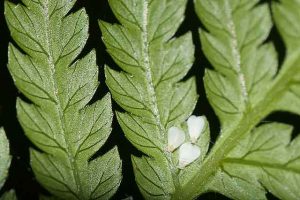
For catching adults, glue traps can be used. To do this, take pieces of plywood or hardboard, paint them yellow or white and grease them with petroleum jelly, rosin with honey or castor oil.
Insects attracted by bright yellow or white (preferably yellow) color, sit on these baits and stick. When a lot of them are typed on a piece of plywood, they wipe it and again lubricate it with the same solution. You can also use glue traps for flies, which are sold in any hardware store.
Have you noticed white midges on indoor plants that immediately take off, you just have to touch the leaves with your hand? These are whiteflies. Whiteflies are a species of small aphid with white wings that inhabit the underside of plant leaves.
- Whiteflies on indoor flowers are a fairly common occurrence. Where they start from is also unclear, but they have preferences, for example, royal pelargonium, small-leaved carmona, nephrolepis, chtenant, aglaonema, and clerodendrum. Whiteflies also greatly harm vegetables in greenhouses, such as radishes and cabbage.
- If in summer indoor plants are on the open veranda or in the garden, then whiteflies will also not take long to wait. Whiteflies quickly multiply, eating plant sap, weaken them. Plants look oppressed, do not bloom, leaves fade.
- Whiteflies leave behind sticky dew, very similar to aphid and scale insects, which serve as fertile soil for the development of fungal diseases. If you notice such white midges, touch the leaves: they will turn out to be slightly sticky or sticky to the touch.
- Usually whiteflies sit on the underside of the leaf, where they lay their eggs. Do not put off the fight against whiteflies if you suddenly find them, because it is quite difficult to deal with whiteflies. During spraying, they fly away, hide, and then, as the smell of the insecticide disappears, they again sit on the leaves.
- A leaf of calathea, which was inherited from whiteflies: numerous puncture bites are visible in the lumen. Whiteflies were spotted and rendered harmless in time, but leaf decorativeness suffered damage And this is the reverse side of the leaf after the attack of whiteflies.
Black dots are visible, they are very sticky to the touch and serve as fertile soil for the development of fungal diseases. Such leaves can be washed with a damp cloth and soap or shampoo. If the leaves are tender, then it is better to remove them.
Therefore, it is necessary to process not only one plant on which whiteflies were found, but also neighboring plants, and also wash window frames and glasses in order to remove all the ways of “retreat” to whiteflies.
It will have to be treated with an insecticide every week for a month and a half to remove all insects, (those that hatch their laid eggs). The insecticide does not affect the eggs, so repeated treatments are necessary.
Yellow glue traps will also help in the fight against whiteflies. You know, I found another way to control pests of indoor plants. On the kitchen window, she placed a dishwasher with an open valve next to flower pots. And the flies die, and mosquitoes, and other insects are not visible.
Cicadas bounce high, you just have to touch the leaves. Even whiteflies can be confused with cicadas - small winged insects of green, brown or yellow color. Cicadas also live on the lower surface of the leaf with which they suck juice.
Plants after attacks of cicadas also look oppressed, the leaves gradually fade. The cicadas are pretty easy to spot: just touch the leaves as they bounce high. Yes, and the appearance of the cicadas is quite large, up to 5-8 millimeters in length.
The attack of cicadas is rarely serious, a single treatment with insecticides is sufficient, and it is better to remove strongly damaged, wilted leaves.
Attacks of whiteflies on plants are a real problem for gardeners, gardeners and gardeners.After all, these annoying pests are capable of not only superficially affecting cultivated crops, but also transmit many viral diseases from which plants die. What methods of controlling whiteflies exist?
How to identify larvae and adults
Reproduction and distribution of whiteflies occurs in several stages. First of all, eggs are laid by the female (usually on the underside of the leaf). They have a small stalk that allows them to move around and look for a suitable place for food.
Fully hatched larvae resemble a gray crumb. They are also located on the lower surface of plant leaves. At this stage of their development, they are absolutely not susceptible to the damaging properties of insecticides. As they develop, they feed on plant juices and contribute to the spread of black soot fungus. The leaves of the plants that they damage, deform, dry out and fall off.
Whitefly larva
An adult whitefly is a tiny insect resembling a small white moth with a yellowish abdomen. The length of his body is only 1-2 mm.
Colonies of these harmful insects affect both decorative and garden plants, both in greenhouses and on open ground. An adult releases a special sticky substance that promotes the development of fungus on the leaves, which makes them yellow and dying.
The main types of whiteflies and plants that they damage
Most deciduous trees, such as mountain ash, pear, apple, and some shrubs, are attacked by the so-called ash whiteflies (Siphoninus phillyreae). Its larvae are distinguished by wide strips of white powdery coating on the back and a fringe of thin tubes with droplets at the ends.
Citrus whitefly (Dialeurodes citri) damages ash, gardenia, various types of ficuses and citrus crops. Its fringe larvae do not have edges, but there is a Y-shaped mark on its back. Mature individuals are white.
Crowned whitefly larvae (Aleuroplatus coronata) larvae damage chestnut trees and oaks. They are black in color with a small amount of white coating. Hibiscus, mulberry, banana tree, safe houses and many ornamental plants are a favorite "delicacy" of giant whiteflies (Aleurodicus dugesii).
Where can pests be encountered?
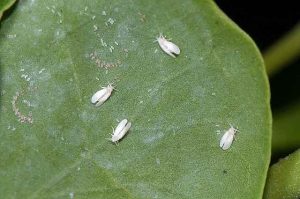
But modern plant care options allow you to create the necessary microclimatic conditions and grow many crops in areas with adverse natural environments.
In nature, there are about two hundred species of whiteflies and many of them over time have learned to adapt to survive and develop in artificial conditions.
A warm and humid atmosphere is perfect for these pests.Therefore, in greenhouses, greenhouses and even apartments with a large number of decorative indoor, it is most likely to face their wrecking attacks.
What is the possible fight against whitefly
In severe forms of infection with whiteflies, it is very difficult to fight with their sabotage and spread. Most insecticides do not help get rid of whiteflies, they give a weak effect, and it quickly disappears, since larvae are completely not susceptible to chemicals.
You can remove a certain amount of insects manually. So the leaves on which the larvae and adult individuals of the pests are located are ripped from the trees and burned. To get rid of pests indoor flowers and plants, you can rinse the leaves with infusion of garlic or yarrow.
At home, they also hang adhesive tape around the affected plants to catch adult butterflies. It also helps placement near objects that have a large surface, the color of which resembles sunlight (white-yellow-golden).
Some special preparations can also help get rid of whiteflies. These include Fosbezid, Furanon, Mospilan, Confidor, Verticillin Zh, Actellik, Decis, Inta-virus, Fitoverm, Kinmiks.
Whitefly on indoor plants, how to fight?
Whitefly is a small white insect up to 3 mm long. The wings are covered with white powdery pollen. It feeds on the sap of plants, which causes irreparable harm to them, up to death. On the surface of the leaves, whiteflies lay many brown eggs, from which larvae emerge. Larvae barely reach 0.3 mm in length.
How to detect
In the first hours, larvae move around the plant until they find their place. In the future, they remain in place until fully ripe eating juice. Adult insects fly and breed well. Pests are often found on the underside of a leaf plate.
Any flying white moth indicates the presence of whiteflies near. She is thermophilic and prefers warm greenhouses and homeliness. There are a large number of pests, some of them are able to survive in open areas in the middle latitudes with a temperate climate.
Like aphids, whiteflies leave glistening deposits on the leaves - honey dew. This is a waste of life. Honey dew, provokes the appearance of soot fungus, in the form of gray, or black spots.
External signs of the plant: growth stops, fades, loses decorativeness, leaves turn yellow and curl.
Risk plants
Whiteflies are attacked by more than 300 species of shrubs and herbaceous plants.
Most often attacked:
- aster,
- balsam,
- begonia,
- cornflowers
- pear,
- melon,
- St. John's wort
- eggplant
- heliotrope,
- gardenia,
- willow,
- St. John's wort
- strawberries
- gooseberry,
- alfalfa,
- cabbage,
- potatoes,
- lemon,
- orchid,
- mint,
- ferns
- petunia,
- parsley,
- sunflower,
- celery,
- the Rose,
- soybeans
- to dream
- beans
- ficus
- fuchsia,
- chicory,
- sage,
- Apple tree.
Whitefly conditions
The appearance of any pests, or diseases, is accompanied by improper and impaired care, the creation of favorable conditions for their appearance and further reproduction. Consider the conditions under which the likelihood of a whitefly attack on a flower increases.
In winter, choose warm rooms, greenhouses, greenhouses. They are able to move from one plant to another, infecting the entire garden.
To prevent the appearance of whiteflies, you must follow a few rules:
- The room should be regularly and well ventilated.
- Flowers are planted at a certain distance from each other
- Keep moderate humidity
- Do not spray at low temperatures with high humidity
- Regularly treat the plant with growth stimulants (epin, houseflower, etc.) and makes fertilizers.
Whitefly Ways
There are several recipes and methods for preventing and killing pests. They can be divided into 2 main groups: purchased funds and using folk methods. In addition, there are various traps and fumigators.
It is difficult to say which method is best, it all depends on the degree of damage and the plant itself. Purchased chemicals can destroy whiteflies in a few hours.
Traps - the principle of action
Traps are designed to capture only adults. Often these are adhesive or sticky films. Use purchased, or make it yourself. It consists of a sheet of cardboard on which adhesive is applied in a liquid state, which does not dry out for a long time. They are hung above the plant. The components are selected odorless and toxin free.
Traps are painted in bright colors to attract pests. They are widely used for any purpose, from mosquitoes, flies, aphids, thrips and other insects. Cooking at home is not such a difficult job.
Can be installed in a pot on a rigid support. Regularly as the flies adhere, the traps must be cleaned, or replaced with new ones. Flotation tapes, which are also suitable as traps, are also sold in stores.
What is a fumigator?
This is an electric device into which either a special plate with harmful substances from insects is inserted, or a container with liquid. When heated, the plate heats up (or the liquid evaporates) and releases a smell into the air that mosquitoes, including whiteflies, cannot tolerate.
Pre-indoor windows and doors are closed. Being in the room yourself is not recommended. The fumigant switch on for a short time 30-60 minutes.
Whitefly Control
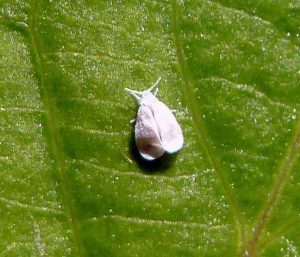
In the later stages, it is necessary to use purchased strong chemicals.
Preventative measures
The larvae on the bottom of the leaf, before birth, spend 1 week.
To reduce the number of larvae, once a week, wipe the leaves with a rag or sponge dipped in water.
You can use a soap solution. But this method is effective with a small number of plants and at the initial stage of the appearance of pests. In greenhouses and greenhouses, it is less efficient and time-consuming.
With the temperature rising above 15 degrees, the larvae will begin their active growth. Destroy weeds when it comes to open ground.
Folk remedies
Soap solution. Use household or tar soap. Pre-soap is crushed and diluted in water in a ratio of 1: 6. Beat the soap solution until foam and sponge it on the leaves. You can use a bullet machine, but without preliminary whipping into foam. A pot of soil is covered with polyethylene.
Beware of getting the solution in the lower layers of the earth. If necessary, after 5 days, the procedure is repeated.
Garlic. Downtime is an effective way to wash garlic tincture. 2-3 cloves of garlic chopped and pour 1 liter. water. Then tightly close and insist for at least 1-2 days in a dark place at a temperature of 20 degrees.
The resulting solution is sprayed with plants 1-3 times with an interval of 1 week.
Yarrow. 100 grams of crushed leaves pour 1 liter of water, cover and insist 2-3 days. The resulting infusion is sprayed with the affected leaves. Usually enough 1-3 times with an interval of 5 days.
Tincture of sugar. In 200 grams, dissolve 2 tbsp. tablespoons of sugar. Spray the affected flowers with the resulting solution. The procedure is repeated after 5-7 days. If the whitefly has disappeared, after a week, the leaves are wiped from sugar coating with a sponge with warm water.
Dandelion. To prepare the infusion, use the ground and underground part of dandelion. The root and leaves, taken at 50 grams in powdered form, pour 1 liter of water. Cover and let it brew for 2 days, then spray 2-3 times with an interval of 6-7 days.
Alcoholic extract of a feverfew. 25 grams of feverfew is poured 100 gr. alcohol, tightly close and insist 12 hours. Then, for 20 grams of infused extract, add 5 grams of laundry soap and pour 1 liter of water. Spray cooked infusion once a week.
Repeat until the pests disappear completely. Instead of feverfew, chopped hot peppers, or millennials, can be used.
I am an amateur florist, but I have a lot of flowers both in the house and on the street. Whitefly generally always appeared in the winter. And always, for some reason, the first thing that my calatheas suffered was, then the senpole, and hibiscus and syngonium were always the last. When I was just dealing with flowers myself, there were no pests, but then I started going to sessions and in the winter I asked to look after the mother-in-law. My plants began to suffer immediately. The reason is a lot of water, they all just swam. I had to transplant everything urgently and process it. For some, just a soul was enough. Here is the hibiscus, it is large, it is sprayed with a light solution of water and laundry soap, and then under an outdoor shower. So 4-5 times and everything was gone. And the smell of pelargonium seemed to me to frighten off the whitefly. Since the senpolis that stood nearby were never amazed. This year I have a little more pelargonium, and mostly fragrant, so I'll put it between other flowers. And your article is very informative and so informative, have never read so much about such a small midge. I will also use tips. Thanks.
Of course I don’t know much about them.But just a few days ago, small midges appeared on indoor roses, and there are so many of them, white and white. Mom said that she faced this at work, but not one of the poison remedies came up. And I had to cut roses on the very trunks, no leaves. We realized that fighting them is useless. And we had to cut the roses as well. It was very sorry. If they appear again in the future, then I will definitely resort to the methods described in the article, because I won’t be able to cut roses for the second time, because it’s a pity the miracle that you raised.
Whitefly is a very tenacious plant pest, experienced it on its own experience. Once we bought petunia seedlings on the market and accidentally brought these midges. This is a very unpleasant insect that can ruin a flower in a few days. For the second year now I have been struggling with this pest by various means - nothing helps. The only thing that reduced their numbers was a good ventilation of the balcony and spraying with garlic water. These midges are very afraid of the wind and pungent odors. I’ve heard from friends and now I’ve read about Actara here, if they appear again, I’ll probably buy this product.